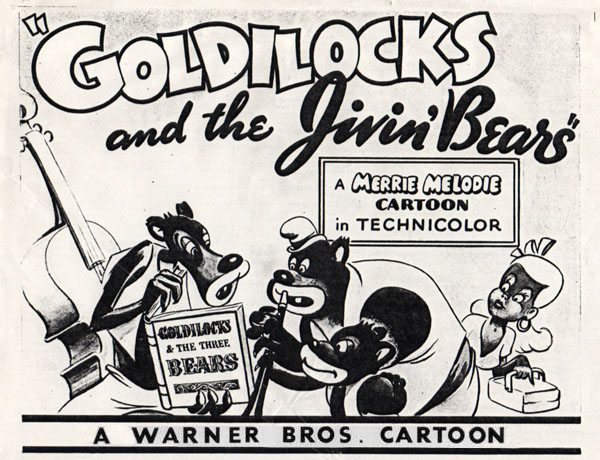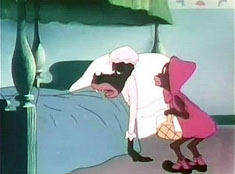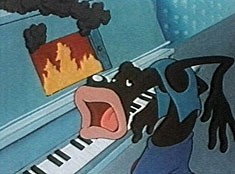
Goldilocks and the Jivin’ Bears, a “Merrie Melodies’ episode from 1944, has several distinctions. It is the most recent of the Censored Eleven cartoons from Warner Brothers. The film is also the only film among the eleven to have been produced by Eddie Selzer, who replaced his predecessor Leon Schlesinger earlier that year. The cartoon is also unique in the list for having a wide array of creatures with African American caricature; three humans (Red Riding Hood, Goldilocks, and a messenger), three bears, and a wolf all have big lips and speak in dialect. In other episodes the caricature is either only on people, as in Clean Pastures, or on animals, as in Tin Pan Alley Cats. The mixture in Goldilocks and the Jivin’ Bears is reminiscent of Metro-Goldwyn-Mayer’s cartoons pairing an African American boy named Bosko with big-lipped caricatures of jazz musicians as frogs.
 By the time of Goldilocks, Warner Brothers had already parodied the old story in Bugs Bunny and the Three Bears, which features a family of bears. Interestingly, the African American bears in Goldilocks are not a family but three male bears of different sizes living in the same house. They leave the house, and a wolf looking for Red sees Goldilocks enter the bears’ house. Just as he catches her in the house, the bears return and mistake the wolf’s entanglement with Goldilocks for jitterbugging. The bears proceed to play jazz, and Goldilocks is compelled to dance with the wolf until he is exhausted. He goes to Red’s grandmother’s house to rest, but the bears find him and resume playing jazz. Red and her grandmother insist of dancing with the wolf–much to the wolf’s frustration.
By the time of Goldilocks, Warner Brothers had already parodied the old story in Bugs Bunny and the Three Bears, which features a family of bears. Interestingly, the African American bears in Goldilocks are not a family but three male bears of different sizes living in the same house. They leave the house, and a wolf looking for Red sees Goldilocks enter the bears’ house. Just as he catches her in the house, the bears return and mistake the wolf’s entanglement with Goldilocks for jitterbugging. The bears proceed to play jazz, and Goldilocks is compelled to dance with the wolf until he is exhausted. He goes to Red’s grandmother’s house to rest, but the bears find him and resume playing jazz. Red and her grandmother insist of dancing with the wolf–much to the wolf’s frustration.
The cartoon received positive reviews when released late in 1944. It escaped the criticism of African American newspapers and civil rights groups at the time, perhaps because the animals dominate screen time in Goldilocks; other films like Angel Puss and Sunday Go to Meetin’ Time were targeted for their African American human leads. Goldilocks performed well enough to warrant a “Blue Ribbon” reissue in 1951, and it still avoided controversy at that point. But the reissue was at the tail-end of the era of animated African American caricature; within a few months, the maid of MGM’s “Tom and Jerry” series made her final appearance in Push-Button Kitty.
 Even with the original release in 1944, the African American jazz cartoon was on its last legs; Walter Lantz’s “Swing Symphonies” ended the following year. Not only had ethnic criticism begun, but jazz itself had expanded beyond African American stars. Jazz in the 1940s had big-name European American entertainers like Glenn Miller and Benny Goodman. Studios still made jazz cartoons for years afterward, and in 1957 Friz Freleng, who directed Goldilocks, directed a cartoon with a rock-and-roll score–Three Little Bops. The post-1944 cartoons, however, traded African Americans for European Americans and animals without ethnic features.
Even with the original release in 1944, the African American jazz cartoon was on its last legs; Walter Lantz’s “Swing Symphonies” ended the following year. Not only had ethnic criticism begun, but jazz itself had expanded beyond African American stars. Jazz in the 1940s had big-name European American entertainers like Glenn Miller and Benny Goodman. Studios still made jazz cartoons for years afterward, and in 1957 Friz Freleng, who directed Goldilocks, directed a cartoon with a rock-and-roll score–Three Little Bops. The post-1944 cartoons, however, traded African Americans for European Americans and animals without ethnic features.
Why was Goldilocks placed in the Censored Eleven in 1968? The big lips of the bears, the wolf, and the messenger provided visual ethnic stereotyping that animators largely avoided by 1968. The tall bear and the messenger have the sleepy eyes and big lips that resemble the demeanor of lazy characters played by actor Stepin Fetchit, whose prime had long passed by 1944 and certainly by 1968. Also, multiple characters speak in ethnic dialect, and even a letter from Red’s grandmother has the written malapropism “rivetater.” With the placement of Goldilocks on the censored list, the wolf’s dancing finally stopped.
Next month: Last but not least, Coal Black an de Sebben Dwarfs!


 Christopher P. Lehman is a professor of ethnic studies at St. Cloud State University in St. Cloud, Minnesota. His books include American Animated Cartoons of the Vietnam Era and The Colored Cartoon, and he has been a visiting fellow at Harvard University.
Christopher P. Lehman is a professor of ethnic studies at St. Cloud State University in St. Cloud, Minnesota. His books include American Animated Cartoons of the Vietnam Era and The Colored Cartoon, and he has been a visiting fellow at Harvard University.



























Friz would do a Crosby Family themed 1970 Goldilocks (the 1970 cult fave, “Goldilocks and the Three Bears” with Paul Winchell and Avery Schreiber – and the Sherman brothers songs – written by Nanny and The Professor (ABC, 1969-71) creator AJ Carothers… 😉 )
Like Clean Pastures, I love the jazz score of this short, but the big lips and forced stereotypes have prevented them from being true masterpieces. I do like how all the dialogue is in rhyme.
Were any of the characters, at least in voice, supposed to be caricatures of anyone imparticular? The wolf sounds somewhat like Rochester. I’ve wondered who the narrator is.
The big bear resembles Stepin Fetchit but sounds like Louis Armstrong, while the medium-sized bear is Fats Waller.
I believe it’s also supposed to be Fats Waller who opens the short at the piano and serves as the narrator.
Goldilocks actually looks great and is not at all offensive, probably because cartoon creations of Lena Horne were little different than other pinups of the era regardless of race. At first, only the wolf has prominent “lips” since the “black bears” aren’t all that different than other cartoon bears (with one actually being brown). If you play the cartoon with the sound off and not listen to the dialogue accents, you would question why it was even banned.
Then… *gasp*… that final gag just ruins it all with a Red Riding Hood and Grandma that resort to stereotype. Well, the Grandma isn’t too bad, but Red is obviously not Tex Avery’s Red. It was as if the animation team suddenly worried that their cartoon wasn’t “black” enough.
Speaking of Avery, I think of “Rural” Red in Avery’s LITTLE RURAL RIDING HOOD could be judged just as offensive to uneducated rural Caucasian folks with her huge feet and buck teeth. That is what is so interesting about old cartoons. They essentially roasted every race and social class with equal insensitivity.
It’s what I call, Equal Opportunity Offenders!
Thinking of that some more, there was something Chuck Jones wrote about in one of his books on why they prefer animals over humans in cartoons…
I was thinking of that after the Angel Puss review here, but I thought it was interesting to point it out. I suppose humanity alone has always been cariactured in ways that, had it not been done, we wouldn’t really think of it as cartoons as well. People often jojke on the bland, generic look of things when you strip away those layers.
Not forgetting the obnoxious bobbysoxer Red from Freleng’s “Little Red Riding Rabbit”, “TA HAVE!”.
That bobbysoxer Red was one VERY assertive dame, not unlike the wartime taxi drivers and Rosie the Riveters that populated the cartoons then. Add to this the broad-shouldered Nazi seductress whom “woman hater” Daffy confronts in PLANE DAFFY, all of the BOOBY TRAPS Private Snafu avoids, the constant bro-buddy bed sharing and, of course, Bugs Bunny always in drag. These neurotic mostly white male animators working inside their little studio cocoon didn’t quite understand that other species that populated the Paint & Ink department and likely took separate lunch breaks. It is not surprising that Bea Benaderet started voicing most of the female characters around this time (circa 1943) and would remain for a decade until the June Foray era. Bea looked and acted like every male animator’s idealized Mother. The way she mothers Marc Anthony in FEED THE KITTY pretty much sums up how all of these guys wanted mothered.
One thing worth mentioning is that the narration in the beginning is by Ernie “Bubbles” Whitman, Who was a black actor and host and is most notably for the AFRS radio series “Jubilee” of which he was the host in the early years on the program.
This is probably the most benign of the Censored 11, simply because they only put the cast in blackface to put a new spin on the Warner fairy tale parody. Besides the pneumatic lips and dialect, there’s nothing really racist about it because none of the humor comes from the fact that they’re black characters, just from the characterizations and timing – as in any good Friz cartoon.
A small correction though – the cartoon was certainly in production and mostly finished when Leon owned the studio, even if it was released without his name.
And for the record, yes, that’s Lillian Randolph as granny at the end.
Four humans, not three. There is also the grandmother.
I have huge lips, big feet & buck teeth, but found this pretty funny. Go figure.
Quotes from “JLEWIS” above:
I’ll bet you’re a riot at parties.
Is it possible Bea’s tenure had a lot (OK, everything) to do with her large talent, plus a relative lack of women’s roles in the cartoons of the day?
While it’s appropriate to review and critique mores and traditions in need of an overhaul, deep psychoanalysis of 7-minute cartoons, and complete denouncement of society at large really sucks the legitimate entertainment value out of a medium whose M.O. is lampooning everybody and everything.
Yes, they got it wrong once in a while. It’s been noted. File it, let it go, try to do better the next time.
Whatever else may be going on that cartoon, Goldilocks is drop-dead gorgeous!
It should be obvious to everybody here that I am not 100% serious. Of course, I don’t know what was going on in every animator’s mind back then. Yes, I know many were quite comfortable in their relationships with women. Yes, I went a little overboard suggesting the genders might have had separate lunch breaks. Yes, Bea was a multi-talented radio and TV star (Burns & Allen is a favorite of mine) although she is definitely the most “motherly” of the cartoon voices. What can I say? I can not resist.
With all of that said, there have been interesting articles published on Hollywood animation’s limited female influence on the workplace. Even Disney was reportedly timid about promoting Mary Blair and, yes, this was more a reflection of the times than on him.
“While it’s appropriate to review and critique mores and traditions in need of an overhaul, deep psychoanalysis of 7-minute cartoons, and complete denouncement of society at large really sucks the legitimate entertainment value out of a medium whose M.O. is lampooning everybody and everything.”
OK… I have to return to this comment.
I am not sure if you were upset at me personally, we were just misunderstanding each other or you were just making a casual comment on the overall situation that I am overreacting to. Hopefully the last. Certainly it is not my intention to upset anybody here. Then again, people easily get upset with me just discussing the weather, so what do I know? We are going through very volatile times right now when no reaction is ever a neutral reaction. Maybe you think I have personal “issues” that I am placing on people of the past?
I agree that cartoons are… well… just cartoons. Maybe we should not discuss them at all since they are intended to be enjoyed like Oreo cookies and not analyzed to death. I may be wrong to think this, but many posting here, myself included, realize that the creators merely wanted to entertain patrons in theaters so that their product could stand out against the latest newsreel and were not necessarily thinking their product would be viewed on YouTube in the future. Considering the way the major studios were often careless with their vaults in the age before television, few even thought they would be shown on television either.
Likewise, there were society norms back then that do not match today’s norms. While a select few people making cartoons back then may have displayed outright bigotry and racism, the vast majority likely did not set out to offend anybody on a conscious level. Just sometimes unintentionally on a subconscious level because… well… it was the ways things were. Case in point: Chuck Jones realizing later in life that he should not have been involved with ANGEL PUSS and wasn’t terribly eager to discuss it with inquiring minds in his later years.
I do think discussing these are important because… oh, let’s look at this from another angle. Entertainment always, always, ALWAYS shows its age over time. What is offensive about something made seven decades ago may be less so seven decades from now, while something made today may be considered MORE offensive in comparison seven decades from now. We can not predict how tastes will change and what will offend future viewers, but sometimes studying these things… and even my silly comments on men working in a “cocoon” (and, oddly, I was fondly remembering Elizabeth Taylor in GIANT discussing “man talk” when I initially posted, but meant no harm)… are just a way of continuing The Discussion. If nothing else, we can understand ourselves better in these discussions while trying to understand those who were around before us.
I am sorry. Got too deep again.
‘Whatever else may be going on that cartoon, Goldilocks is drop-dead gorgeous!’
Huzzah, GDX!
Unlike the censorable MGM titles, the Warner Brothers cartoons of this type, even the blue ribbonized “GOLDILOCKS AND THE JIVIN’ BEARS” were shown on network or syndicated TV. Some titles added later to that censored 11 list, like the original “BUGS BUNNY RIDES AGAIN” with Yosemite Sam’s original boast, did show up, as did the INKI series, but I was only made aware of the jazz cartoons a la Termite Terrace when I attended animation festivals and read books on the subject. Those were better outlets since kids would not recognize the caricatured celebrities.
The SPEEDY GONZALES cartoons were more considered cat-and-mouse antics, similar to “MOUSE MOSURKA”, also featuring Sylvester the cat. I never quite understood the pairing of Daffy Duck and Speedy. Perhaps that can be discussed in a later post?
Who’s the narrator? The Piano player. Latter sounds like Scatman Crothers. They don’t all sound like Blanc.
As cited in comments above, Ernie Whitman was the piano playing narrator, and Lillian Randolph was Grandma. Sara Berner is Goldilocks and Red; Blanc was the short Bear #3, the Wolf and Telegram guy; Billy Mitchell is bears #1 & 2.